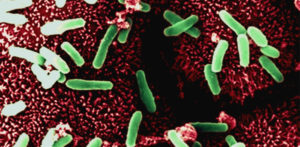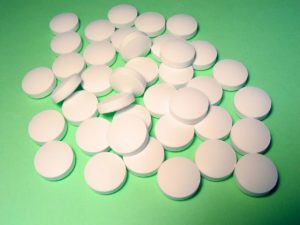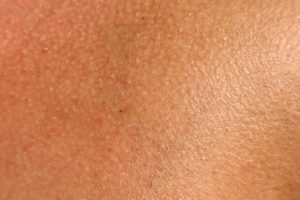 The American Academy of Pediatrics released a new report that the overuse of antibiotics in animals poses a real health risk to children. Giving routine antibiotics to animals leads to antibiotic resistant bacteria - which means that antibiotics may not work when given to people. Most of the antibiotics sold in the U.S. each year - 80 percent- are used in animals that people than eat. The great majority of antibiotics given to animals are the same ones given to humans.The main way to ensure that the meat that you are purchasing is antibiotic-free is to buy meat labeled organic. And to buy organic dairy products (milk, butter, cheese, cream). Note that the reason routine use of antibiotics in animals has not been stopped so far in the USA is due to agriculture industry lobbying. From Medical Xpress:
The American Academy of Pediatrics released a new report that the overuse of antibiotics in animals poses a real health risk to children. Giving routine antibiotics to animals leads to antibiotic resistant bacteria - which means that antibiotics may not work when given to people. Most of the antibiotics sold in the U.S. each year - 80 percent- are used in animals that people than eat. The great majority of antibiotics given to animals are the same ones given to humans.The main way to ensure that the meat that you are purchasing is antibiotic-free is to buy meat labeled organic. And to buy organic dairy products (milk, butter, cheese, cream). Note that the reason routine use of antibiotics in animals has not been stopped so far in the USA is due to agriculture industry lobbying. From Medical Xpress:
Pediatricians' group urges cuts in antibiotic use in livestock
Overuse of antibiotics in farm animals poses a real health risk to children, the American Academy of Pediatrics warns in a new report.This common practice is already contributing to bacterial resistance to medicines and affecting doctors' ability to treat life-threatening infections in kids, according to the paper published online Nov. 16 in the journal Pediatrics.
"The connection between production uses of antibiotics in the agricultural sector to antibiotic resistance is alarming," said Victoria Richards, an associate professor of medical sciences at the Quinnipiac University School of Medicine in Hamden, Conn. She believes the danger is "not only for infants and children but other vulnerable populations, such as the pregnant and the older individuals."
As the academy explained in its warning, antibiotics are often added to the feed of healthy livestock to boost growth, increase feed efficiency or prevent disease. However, the practice can also make antibiotics ineffective when they are needed to treat infections in people. Some examples of emerging antibiotic germs include methicillin-resistant staphylococcus aureus (MRSA), C.difficile, and highly resistant strains of the tuberculosis bacterium. Each year, more than 2 million Americans develop antibiotic-resistant infections and more than 23,000 die from these infections, the academy said. And in 2013, the highest incidence of such infections was among children younger than 5, federal government statistics show.
"Children can be exposed to multiple-drug resistant bacteria, which are extremely difficult to treat if they cause an infection, through contact with animals given antibiotics and through consuming the meat of those animals," report author Dr. Jerome Paulson, immediate past chair of the academy's executive committee of the Council on Environmental Health, said in an academy news release."Like humans, farm animals should receive appropriate antibiotics for bacterial infections," he said. "However, the indiscriminate use of antibiotics without a prescription or the input of a veterinarian puts the health of children at risk."
Spaeth noted that the U.S. Centers for Disease Control and Prevention, as well as the World Health Organization, have both called for a curbing of antibiotic use in animals. But the authors of the new report expressed concern over resistance from the agriculture and farming industry to such measures.

 People spend a lot of effort trying to repel mosquitos - because the bites are so annoying and because they spread serious diseases. New research looking at different mosquito repellents - both DEET and non-Deet ("natural") products - had interesting results. What was once thought effective in repelling mosquitoes doesn't work at all (vitamin B patch), and what was thought attractive to mosquitoes may actually repel them (floral scents), and the "natural" alternatives may or may not work. Also - the
People spend a lot of effort trying to repel mosquitos - because the bites are so annoying and because they spread serious diseases. New research looking at different mosquito repellents - both DEET and non-Deet ("natural") products - had interesting results. What was once thought effective in repelling mosquitoes doesn't work at all (vitamin B patch), and what was thought attractive to mosquitoes may actually repel them (floral scents), and the "natural" alternatives may or may not work. Also - the  The Y-shaped tube used in the study.
The Y-shaped tube used in the study.  This study found that men who eat a lot of garlic (4 cloves in raw or capsule form) had a "more attractive" body odor to women. This is
This study found that men who eat a lot of garlic (4 cloves in raw or capsule form) had a "more attractive" body odor to women. This is  New research found that one course of
New research found that one course of  New research found that negative health effects - 35% increased risk of cardiovascular problems (coronary heart disease, heart attacks, strokes) are when the vitamin D levels are really low (under 15 nanograms per milliliter). Currently many doctors recommend optimal levels for health as somewhere between 35 to 40 ng/ml. One
New research found that negative health effects - 35% increased risk of cardiovascular problems (coronary heart disease, heart attacks, strokes) are when the vitamin D levels are really low (under 15 nanograms per milliliter). Currently many doctors recommend optimal levels for health as somewhere between 35 to 40 ng/ml. One  Nice update from a large crowd sourced study I posted about
Nice update from a large crowd sourced study I posted about  Could this be? Fungal infection being the cause of Alzheimer's disease? Noteworthy from a recent study conducted in Spain: all the Alzheimer's disease (AD) patients had evidence of fungal infections in their brains, central nervous systems, and vascular systems, but none were found in the control subjects (those without Alzheimer's disease). Many of the symptoms of AD (such as inflammation of the central nervous system and activation of the immune system) match those with long-lasting fungal infections. A "microbial cause" has long been suggested as a cause of AD, and interestingly other studies have also found fungal infections in AD patients. The research so far has found
Could this be? Fungal infection being the cause of Alzheimer's disease? Noteworthy from a recent study conducted in Spain: all the Alzheimer's disease (AD) patients had evidence of fungal infections in their brains, central nervous systems, and vascular systems, but none were found in the control subjects (those without Alzheimer's disease). Many of the symptoms of AD (such as inflammation of the central nervous system and activation of the immune system) match those with long-lasting fungal infections. A "microbial cause" has long been suggested as a cause of AD, and interestingly other studies have also found fungal infections in AD patients. The research so far has found  When suffering from cold symptoms or acute sinusitis, there are some products that work for nasal congestion, and thick phlegm and mucus.
When suffering from cold symptoms or acute sinusitis, there are some products that work for nasal congestion, and thick phlegm and mucus.  The microbes living on healthy human skin include bacteria, fungi, and viruses...but 90% of the viruses found on healthy skin in this study are unknown to researchers - thus "
The microbes living on healthy human skin include bacteria, fungi, and viruses...but 90% of the viruses found on healthy skin in this study are unknown to researchers - thus "